#first form of devi durga
Explore tagged Tumblr posts
Note
Tell us about Subhadra and Arjun.
Did Krishna had influence in their life?
Who was Subhadra closer in Krishna's family.
Sure! <3
Subhadra is born and is named 'Chitra' (just like Balarama's birth-name is Saarana-Sankarshana) on the month Bhadra's Krishna-navami (ninth day of the 2nd/dark lunar fortnight), and she is exactly 18 years and 1 day younger than Krishna (the exact date is most probably folklore, but I still like it). She is described to have a golden-complexion (which would be called wheatish in today’s scale, situated perfectly between Balarama’s fairness and Krishna’s darkness).
She is in most versions the daughter of Rohini and the full-sister of Balarama, but some sources also place her as Devaki's daughter. She is the oldest (or one of the oldest at least) among the 2nd wave of kids that Vasudeva has.
She is practically raised by Balarama and Krishna, and eventually, thanks to her good nature, she comes to be known as Subhadra, and is nicknamed 'Bhadra' thereafter. She is also noted to be the favourite child of Vasudeva; however, he doesn’t hold much weight in the decisions of her life (that mantle is bore proudly by Balarama as the in-practice head of the family). Out of her brothers, she seems close with all of them, but she also knows them in saying that Krishna would probably give in to all her demands and Balarama would go above and beyond to protect her (in however way he feels appropriate).
Some sources also note her as a reincarnation of Yashoda's biological daughter (herself an incarnation of Yogamaya). She is also identified on-and-off with devi Durga, and Krishna's sister Ekanamsha. She is today most prominently worshipped in the Puri Jagannatha temple alongside both her brothers. During the ratha-yatra, it is believed that Arjuna himself becomes her charioteer (in contrast with Kashiram Das' story), driving her ‘darpadalana’ chariot in his form of Brihannala.
Conversely, in shaakta tradition, devi Vimala’s (also Subhadra) shaktipeetha (within the same complex) is the main temple with Jagannatha considered the bhairava of the peetha (Sati’s feet fell here).
Not much attention is given to her childhood as we the readers meet her the same time as Arjuna does, near the end of his 12-year exile from Indraprastha. After leaving Uloopi and Chitrangada to now raise their respective kids, Arjuna arrives in Prabhasa (also used to be the place where the river Saraswati used to meet the Arabian sea). Krishna spends a few days in Prabhasa, living the same way as Arjuna was, pretending to indulge his vana-vasa, but then he practically carries him off to Raivataka, and then ships him straight off to Dwarika, where he is kept with royal honour, his tapasya, thrown happily out the window.
In this festival, Arjuna spots Subhadra and is immediately smitten by her. He stands there, mouth open like a frog, until Krishna notices this. Krishna, a little embarrassed by his personal guest’s behaviour, says, “Vanecharasya kimidam kaamena-lobhyate manah?” [How did the forest-dweller lose himself to desire?]
Krishna then notes her identity: “Mamaisha bhagini Paartha Sarana’sya sahodara” [She is my sister, Arjuna, Sarana’s uterine sibling]. Then he also offers to talk to Vasudeva on Arjuna’s behalf.
The next story I have discussed somewhat here: (x).
In Kashiram Das’ version, it is rather Subhadra who sees and falls in love with Arjuna. She confides in Satyabhama, who scolds her a lot, but eventually melts and talks to Krishna on her behalf. Krishna first laughs at the situation for a solid hour or so and then tells Satyabhama to do whatever is necessary to make this happen. Satyabhama goes and wakes up Arjuna in the middle of the night, with Subhadra trailing along. Satyabhama tries to convince Arjuna in many ways, even bringing up Draupadi’s five-husband conundrum (and that apparently, she uses black magic to control the Pandavas: this is lifted straight from Vyasa’s Satyabhama-Draupadi samvaada in Vana Parva), but Arjuna unequivocally turns them down.
Satyabhama, angry at this, brings Subhadra back and puts some ‘magical vermilion’ on her forehead, which attracts Arjuna so much that he picks Subhadra up on his lap and marries her on the spot (just a note guys, please do not drug your intended partners, magically or otherwise, it’s a stupendously bad idea). Later, when the Yadavas chase the eloping couple, Subhadra helps Arjuna tie up Daruka and then drives the chariot herself.
Dr. Bhaduri notes that Subhadra and Draupadi’s base personalities are similar (this, he considers the primary reason for Arjuna falling for her in the first place…kind of having his own, personal Draupadi that he didn’t have to share, but I personally do not like this very much, too much shadowing in my opinion). The difference lies in the fact that Subhadra, once Arjuna picks her up, pretty much surrenders and then tries her level best to make everyone’s life easier, even at times at the cost of her own independence, family dignity and one-and-only son. This we see when she agrees to go before Draupadi dressed in simple clothes (of a gopi, in practice, an attendant of Draupadi’s, not an equal). She even touches Draupadi’s feet (even though I feel Subhadra is older than Draupadi, but there’s no textual clarification on that).
Soon after this, Balarama and Krishna appear in Indraprastha with Subhadra’s dowry. Balarama performs the bride’s father’s rituals as Vasudeva doesn’t come, for whatever reason (could range from health issues to anger at Subhadra/Arjuna). Disguised as the dowry however, Krishna manages to add significantly to the army of Indraprastha.
Subhadra is not as interested or involved in the political kernings of the story that starts after her marriage. She’s happy just being a wife and a mother, and well, to each their own. She is happy, and that’s all that is important. Dr. Bhaduri describes Subhadra as ‘mugdha-madhura-lajjaaruna’ [enraptured-dulcet-bashful]. After her marriage, and before Abhimanyu’s birth (or shortly after that), she goes on a picnic on Yamuna’s banks with Krishna, Arjuna and Draupadi. Here we see, how much successful Subhadra had been in capturing the heart of not only Arjuna but also Draupadi as we watch the two co-wives enjoying the dance performances together, as they throw expensive jewellery and clothes (at one point their own as well, but that’s a different conversation) at the dancers as tips. Draupadi also has, in many occasions, confirmed that she loves Abhimanyu as much, if not even a little more than, her own children. It is hard to believe that not even a portion of that love would be directed towards Subhadra too.
When the Pandavas have to go their 13-year exile, Krishna takes Subhadra and Abhimanyu with him to Dwarika, and it’s there that she spends all those years until she is summoned to Upaplavya to the wedding of her son to Uttara.
Dr. Bhaduri notes that during the Kurukshetra war, Draupadi stayed back in Upaplavya, but Uttara and Subhadra went with the army, and stayed in a tent (Arjuna’s personal one) near the battlefield. Here, Subhadra probably went to take care of Arjuna after all these years of being apart, and Uttara probably went on a really twisted version of a honeymoon. Vyasa however, doesn’t reveal their presence until after Abhimanyu’s death where we see Subhadra’s one-and-only outburst.
After that tragedy, Arjuna did not have the courage to face her. He rather sent Krishna to break the news to her first. She doesn’t attack the Pandavas directly, like Draupadi usually does in adverse situations. Subhadra, goes on to blame herself, along the lines of, “Why did you have to die when the Pandava-Panchala-Vrishni warriors are still alive!” Then it seems like she starts hallucinating, as if Abhimanyu is alive, and again a baby, as she begs him to crawl to her. She does blame the Pandavas by name after this, and prays for a comfortable journey to and a happy lodging in heaven for her son and then soon after we see her pull herself together to an inhumane level and focus her entire energy on consoling Uttara.
Within these few hours, seeing Subhadra break down like no one had even seen her before, the Pandavas, a bit afraid, had Draupadi summoned from Upaplavya on priority to come and take control. Once Draupadi reaches the field, Krishna unceremoniously dumps Subhadra and Uttara on her and himself goes to counsel Arjuna. I feel like he too was uncomfortable watching his long-pampered little sister break down like that and not being able to correct the situation for her.
When Parikshit is born, Subhadra herself runs to her brother, begging him to save the baby, saying, “The Pandava brothers wouldn’t survive if this last hope were also to die!” Even now, when she herself has lost her son and in on the verge of losing a grandson, she thinks only of others.
In the end of the story, too we see Subhadra’s selfless nature, when Draupadi goes with the Pandavas towards the Himalayas, Subhadra stays on as the queen-regent, sharing the responsibility with Yuyutsu with Kripa’s guidance. She definitely loved Arjuna, enough so as to not want to live on without him, and yet we see her make that decision, primarily because in Krishna and Arjuna’s absence, she realizes that someone smart needs to stay here, to protect and guide and rebuild these two idiot dynasties, in Hastinapura and Mathura, at least until Uttara is old enough to take on the burden.
Subhadra, very appropriately, fades out of the narrative as softly as she had come into it. She doesn’t need to make any grand gestures to still shine within the narrative.
74 notes
·
View notes
Photo
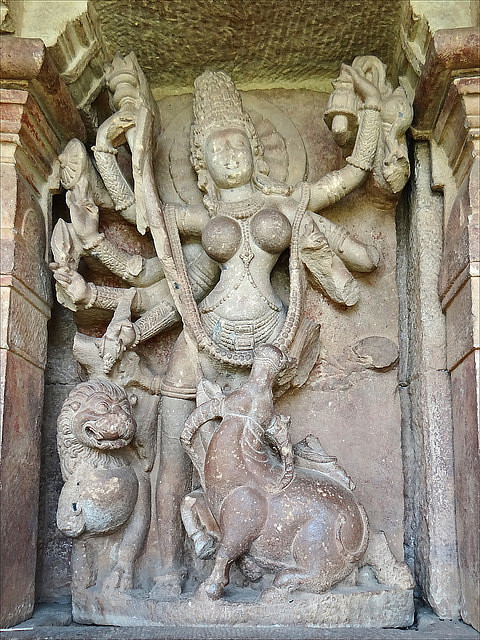
Devi
Devi, also known as Mahadevi or 'Great Goddess', is an all-embracing Mother Goddess first worshipped in India in Prehistoric times. In the Vedic period, she was assimilated into the Hindu pantheon and so came to represent the female energy or Sakti (Power) of her husband Shiva. Both Devi (meaning goddess in Sanskrit) and Sakti may also be used more generically to reference any female Hindu goddess, especially Parvati, Lakshmi, and Sarasvati. Devi is most often manifested as the fearsome female warriors Durga and Kali, both of whom famously killed a number of terrible demons in Hindu mythology. Devi is also the mother of Nandi, Shiva's doorkeeper and bull; Skanda, the six-headed god; and Ganesha, the elephant-headed god.
Devi's character has two opposing sides represented by various separate female deities: as Uma, the benevolent, and as Durga, the terrible. It is as the latter, more fierce personification that she is most frequently worshipped. Her dark side can also take the form of the fearsome black goddess Kali. The deity has a myriad of many other names and may, for example, also be referred to as Vindhyavasini, Kanya (the Virgin), Mahamaya (the Illusion), and Bhutanayaki, the queen of the Bhuta, those ghosts and goblins who haunt graveyards, make the dead live again, and trick the living so that they might feast on their flesh.
The Two Sides of Devi: Uma & Durga
Devi's more benevolent side is worshipped as Uma, and this facet of her character is represented as both beauty and light. This softer side is also referred to as Jaganmata (Mother of the World), Gauri (Yellow and Brilliant or Golden), Bhavani, Haimvati, and Parvati (the Mountaineer).
Devi's dark side is represented as the terrible Durga (the Inaccessible) who has ten arms, an impressive armoury of weapons, and who rides a magnificent lion or tiger. This side is further manifested in the forms of Kali, Kalika or Syama (the Black Goddess); Candi or Candika (the Fierce), in which guise she killed many a demon or asura; and Bhairavi (the Terrible). Worshippers of this face of Devi seek her favours and dark powers and so make blood sacrifices and perform wild rituals in the ceremonies of Durga-puja, Carak-puja, and the Tantrikas which call on Durga's sexual and magical powers.
Continue reading...
82 notes
·
View notes
Text
The dance of the devi
Flowers for the goddess
in my alta-dyed hands,
I offer them at the lotus feet
of the Mother of the Universe.
***
Gentle blues of the skies move out
And Surya slowly rises from slumber
in its captivating regal glory,
its golden rays adorning
the Devi’s forehead.
***
I behold the golden complexioned goddess
set in stone with a benevolent smile.
My anklets lay at her feet
with turmeric and vermillion coating
some of those melodious bells.
***
A sweet summer breeze blows by.
A bell jingles and a lotus from her garland
falls to the brown earth at my dust laden feet.
A jingle of bangles and anklets,
A low hum of a mysterious yet beautiful tune,
And a voice sings,
A voice that I can recognize anywhere –
The Devi has risen!
***
Draped in silks and gold,
fragrant garlands around her limbs,
She steps outside to my courtyard,
A very humble stage for the one
who is the abode of this entire Universe.
The sun makes her ornaments gleam,
yet her moon-like face is the brightest.
My anklets are around her feet
But what truly do I own
in this illusionary world?
What I receive –
Beauty, intelligence, riches and power,
All comes from her.
***
And by the bright yellows of dawn
I see her dance in my courtyard.
Wherever her feet travel, little blooms arise
and where her hands softly touch,
Golden dust flies.
She twirls round and round
And I see the might cosmic Gods
Swirling around her magnificence.
Her veil, the illusionary veil,
which she playfully casts
around this world
escapes the clutches
of her beautiful braided hair.
And now I see. Clearly.
***
She leaps into the air,
Resembling a warrior
and a warrior she is,
for she is the Devi,
The ferocious Bhairavi,
The invincible Durga,
the slayer of Mahishasura.
She is the dark one, Kali,
The slayer of Raktabija.
***
Her dance of grace and elegance
transforms to a dance of death and destruction.
She is Shivatrinayani and Maheshwari.
She leaps and twirls with her trident
and her anklets and the temple bells ring
harmoniously,
Just like the eternal forces of nature.
Devi is Nitya, the eternal one.
***
I, a mere mortal woman, a devotee
akin to the turmeric and vermillion on her feet
watch the goddess dance in all her glory.
I see all the worlds and this vast universe
dance with her,
And maybe it is really true:
That everything in the world dances.
Laasya performs in every object,
in the largest to the very smallest.
***
And then I see the radiant one
stretch her palm to me.
I see my world in her hand
And clasp her hand tightly.
Which daughter lets go of her mother’s hand?
So we dance.
***
Stars and galaxies, planets and cosmic bodies,
Fire and snow, gods, demons and mortals,
I see her in everything
And this is the Dance of Realisation.
The music, the drums and the bells slowly fade
But the dancing soul now awakened
dances in ecstasy.
I see, I hear, I dance, I understand everything now.
***
The Devi twirls, spins, sings, smiles and laughs
And finally heads to her abode, to Shiva, her life.
My life, a thread in her hands,
I now submit to her eternal play
of this Life’s Dance.
***
I haven't written poetry in a while now. Somehow I couldn't capture this in a story format, it felt bland and very large and long. I didn't like it. The poem format perhaps gives me a little peace to form the vision I once had a few years ago while meditating on the goddess. I will obviously edit this later for the book, but for now here's the first draft poem for the book
Tagging: @swayamev @indiansapphic @jukti-torko-golpo (big thank you to you for the devi content!) @navaratna @rhysaka @krishna-priyatama @krsnaradhika @inexhaustible-sources-of-magic @alhad-si-simran @ramcharantitties @kaal-naagin
95 notes
·
View notes
Text
It's the final day of Navaratri, a 10 day, or 9 night, Hindu festival celebrating the 9 forms of the Goddess Durga. ✨Jai Durga Maa✨
Today though I figured I would post each of these forms here in one big post that celebrates each of her forms and victories over the past 10 days. I hope you enjoy.
Keep in mind there are many different traditions and versions of these myths, and I am not a Hindu, so your own research is always advised.
✨Shailputri✨
✨Om Devi Shailaputryai Namah✨
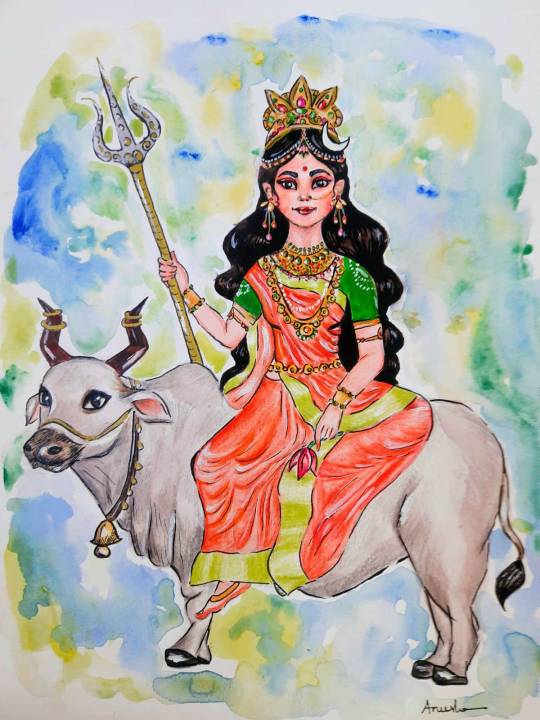
The first day of Navaratri celebrates Durga as Shailaputri, considered the absolute form of mother nature.
The colour of the day is yellow and she connects us to the root chakra, the foundation of Shakti.
She teaches patience, strength and grounding, keeping us firm in our beliefs. Meditating on her here represents the beginning stage of the journey to awakening, the first chakra activated when working with Kundalini. It is also said that the worship of Shailaputri on this day will ward off ill effects of the moon.
Her story goes as follows: Sati, also known as the daughter of the mountain, against her father's wishes becomes the wife of Lord Shiva. Not agreeing with Satis choice of partner, her father arranges a great party in which he invites all the gods, goddesses and holy men, everyone except Shiva and Sati. Upset and angry at this insult Sati crashes the party then throws herself into a fire, killing herself, later incarning as Parvati.
✨Brahmacharini✨
✨Om Braam Breem Broom Brahmcharinyai Namah✨
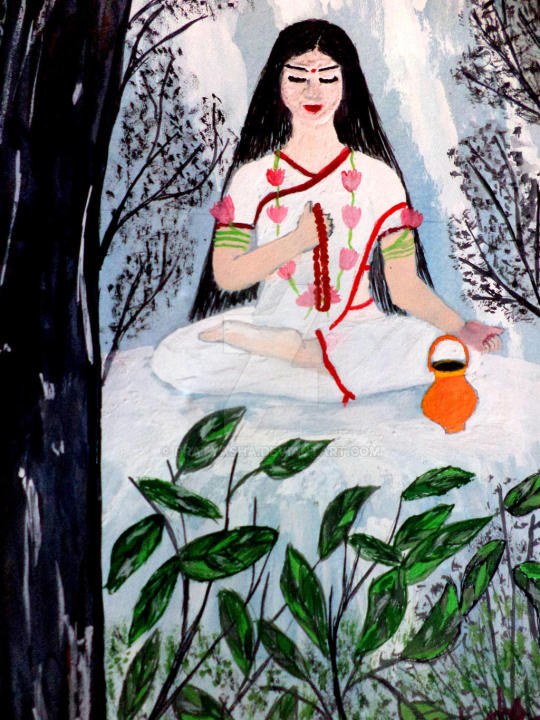
The second day of Navaratri celebrates Durga as Brahmacharini.
The colour of the day is green and she connects us to the Sacral Chakra.
She teaches perseverance, devotion, peace of mind, love and harmony. Meditating on her this day is said to bring the devotee victory in all their endeavors and the ability to persevere and stay balanced mentally in order to tackle any obstacles or duties that one faces.
Her story goes as follows: After Sati's death, Shiva goes into deep meditation that lasts for many many years, abstaining from all desires. Shiva, so deep in meditation, doesn't realise that Sati has reincarnated as Parvati. Parvati, wanting to marry Shiva once again in this life, is told that the only way she can marry him is if she undergoes a severe penance. Parvati then spends thousands of years in meditation, eventually eating, drinking and breathing nothing in devotion to Lord Shiva, in the hopes that he notices her and recognises her once more.
✨Chandraghanta✨
✨Om Hreem Kleem Shreem Chandraghantayai Namah✨
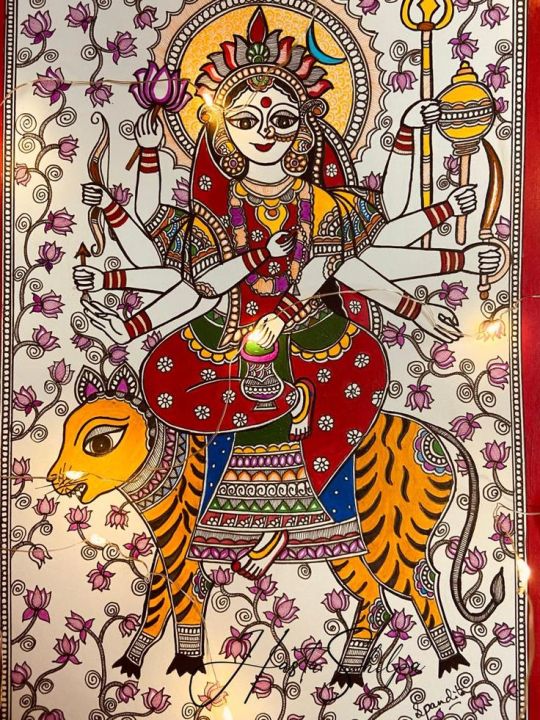
The third day of Navaratri celebrates Durga as Chandraghanta.
The colour of the day is grey and she connects us to the Solar Plexus.
She teaches justice, discipline, strength and power. Worship of her on this day is said to remove all evil spirits and obstacles, dispel sorrow and negativity and bring peace, grace and serenity to her devotees. She will also bless her devotees with a warrior spirit imbued with courage and might, so, like Chandraghanta, we are always confident and ready to fight for our own and others well-being.
Her story goes as follows: When Shiva is finally brought out of meditation and notices Parvati, he is happy with her devotion to him and agrees to marry her again. On the day of the wedding Shiva appears in his terrifying form, shocking and scaring the wedding guests. In response, and to ease the minds of the wedding guests, Parvati also changes herself into her terrifying form, Chandraghanta, and the two are wed.
✨Kushmanda✨
✨Om Hreem Kushmandayai Jagatprasootyai Namah✨
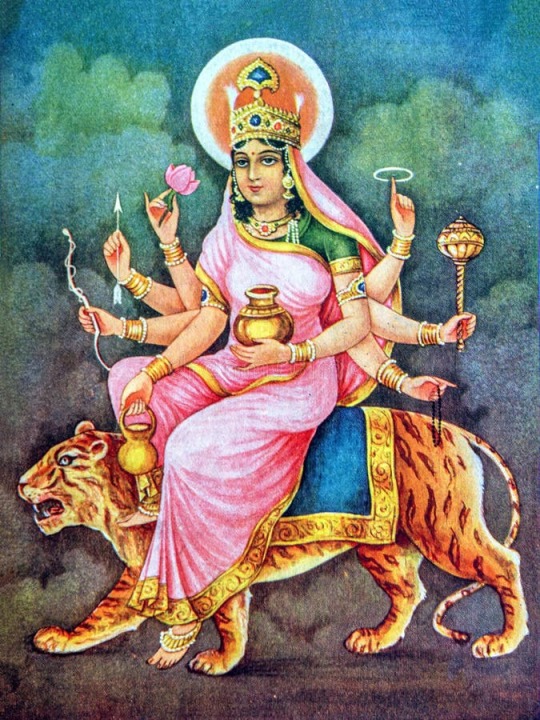
The fourth day of Navaratri celebrates Durga as Kushmanda, considered the creator of the universe.
The colour of the day is orange and she connects us to the Heart Chakra.
She teaches purification, clarity and creative energy. Worship of her on this day is said to remove planetary flaws and imbalances, purifies the darkness from bad actions or karmas, removes evil or negative energy, brings in good energy and a positive aura, sheds light on our path, promotes business which brings about success and opportunities, boosts creativity and concentration, builds harmonious relationships with others, and promotes good physical, mental and spiritual health.
Her story goes as follows: When the universe didn't yet exist and all was darkness, Kushmanda created the universe with her smile, filling the universe with light. She is believed to reside in the centre of the sun and embodies the source of all life. She created all the other gods, who go on to create other universes, beings and life forms.
✨Skandamata✨
✨Om Hreem Saha Skandmatryai Namah✨

The fifth day of Navaratri celebrates Durga as Skandamata, the mother of Skanda (also commonly known as Kartikeya), the commander-in-chief of the gods.
The colour of the day is white and she connects us to the Throat Chakra.
When we connect to Skandamata by proxy we also connect to Skanda, receiving both of their blessings.
Skandamata teaches us to nurture and protect children, have purity of intent and find ways to grow our knowledge. Worship of her on this day is said to promote fertility, prosperity, courage and wisdom. She blesses her devotees with a clear mind and a feeling of tranquility, she can pacify the heart and bring a life filled with contentment, prosperity and achievement for those with pure and selfless intentions, bringing many rewards. She will protect her devotees with a mothers love, giving them strength and power. It's also said that she can lead her devotees down the path of salvation, liberating them from the cycles of birth and death.
Her story goes as follows: When Shiva detached himself from all worldly affairs and went into deep meditation after the death of Sati, the demon Tarakasura was given a boon which only allowed the son of Shiva to kill him, and as such was free to wreak havoc. Parvati, after her severe penance was able to marry Shiva, and together they created an incredibly hot and fiery seed. Agni, the god of fire, was tasked with delivering the seed but the seed was far to hot. So Durga takes the form of water and carries the seed to a lake where Skanda is born. Skanda then goes on to become the commander-in-chief of the gods and fulfils his destiny, killing the demon Tarakasura.
✨Katyayani✨
✨Om Hreem Shreem Katyayanyai Namah✨
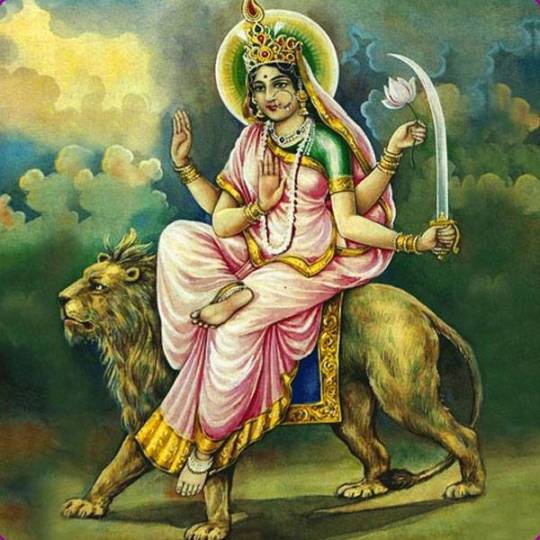
The sixth day of Navaratri celebrates Durga as Katyayani.
The colour of the day is red and she connects us to the Third Eye.
She teaches strength, protection and solutions to issues of love and marriage. Worship of Katyayani on this day is said to bring protection, remove evil spirits, triumph over obstacles, promote success and fame, bring love to those seeking, lead the way to a happy marriage, resolve problems in marriages and protect families. It is also said she will remove the negative powers of aspects in her devotees natal charts, as well as protect from malific planetary transits, remove sins and struggles that one faces, facilitating all round happiness and fulfilment.
Her story goes as follows: The trinity of the gods, Brahma, Vishnu and Shiva, among other gods, were so angry that the demon Mahishasura was wreaking havoc that their anger combined created Katyayani. They each gave her weapons and powers and tasked Katyayani to kill the demon. On her way to do this, Mahishasura was so captivated by her beauty he asked her to marry him, but Katyayani told him that she can only be won in a fight. Mahishasura, determined to win Katyayani's hand in marriage, changed into his bull form ready to fight, Katyayani on the other hand, jumped from her mount with such force she knocked him to the ground, killing him.
✨Kaalratri✨
✨Om Aim Hreem Shreem Kaalratryai Namah✨
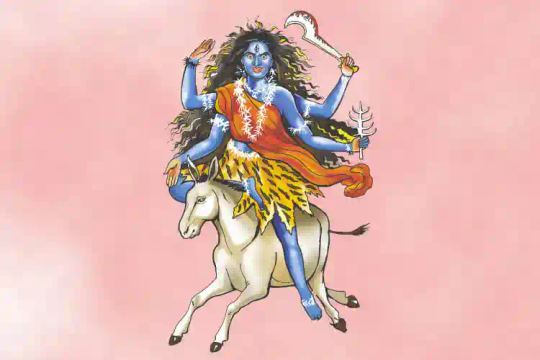
The seventh day of Navaratri celebrates Durga as Kaalratri, also known as Kali.
The colour of the day is royal blue and she connects us to the Crown Chakra.
Kaalratri is commonly known as the fiercest form of Durga, her mere image invokes fear in all those who do evil, she displays no mercy for the wicked. She teaches how to be bold, powerful and destroy ignorance and replace it with knowledge. Worship of her on this day is said to remove black magick and malevolent spirits of all kinds, they flee in terror when she is present. She removes fears, negativity and obstacles giving us the power to be bold, courageous and successful. She destroys ignorance and blesses her devotees with knowledge, wealth, power and good health. It is also said she will remove negative aspects in her devotees natal charts that relate to career, troubles with success or aspects that indicate health issues.
Her story goes as follows: The demon Raktabeej had a doon where every drop of blood would spawn yet another version of him, infuriating Parvati. As a result of her anger, Parvati changed into her Kaalratri form, turning her as dark as the night. Filled with rage she slaughters each of the forms of Raktabeej, collecting his blood in a bowl, and drinking it to stop him from multiplying. She did this until only the real Raktabeej was left, whereupon she chopped off his head and drank his blood until he was no more.
✨Mahagauri✨
✨Om Hreem Shreem Glaum Gam Gauri Geem Namah✨
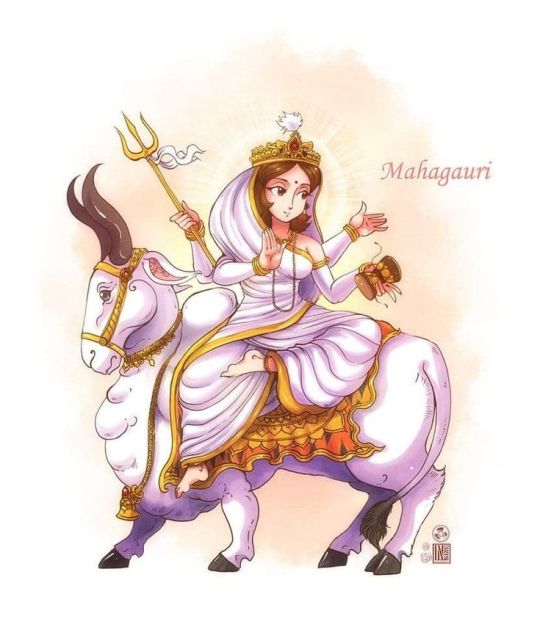
The eighth day of Navaratri celebrates Durga as Mahagauri.
The colour of the day is pink and she connects us to the Soul Star chakra, located just above the Crown Chakra.
Mahagauri teaches compassion, morality, and emotional stability. Worship of her on this day is said to remove impurities, dispel confusion, bring peace, facilitate compassion, lead the way to enlightenment, expand spiritual growth and fulfill desires. She blesses her devotees with a peaceful life, home and family, bringing a good partner to those who are seeking and bless marriages. She will also remove obstacles, negativity and the sins of her devotees, lead to self realisation and promote virtue and emotional stability.
Her story goes as follows: Parvati, after her battles as Kaalratri, was stuck looking as dark as the night, to regain her original form she was told to bathe in the river Ganges. Doing as recommended, she re-emerges from the river more beautiful than ever, as the glowing form of Mahagauri.
✨Siddhidatri✨
✨Om Hreem Shri Siddhidatri Durgaaye Namaha✨
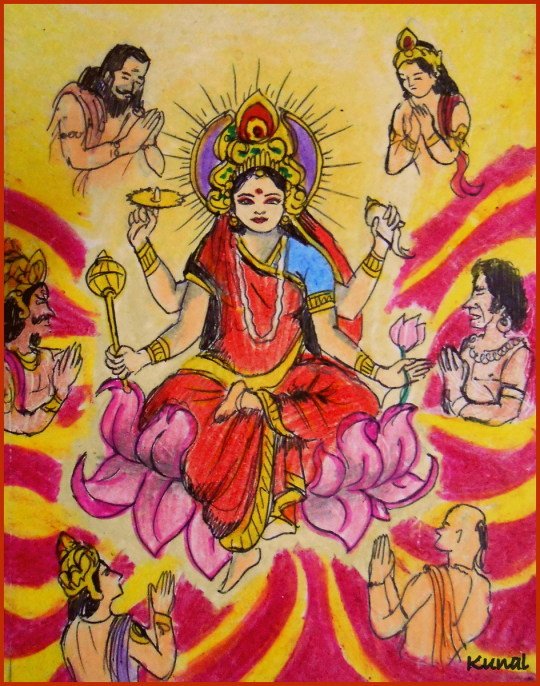
The ninth day of Navaratri celebrates Durga as Siddhidatri, the supreme goddess.
The colour of the day is purple and she connects us to the Universal Chakra, located above the Soul Star Chakra above the Crown.
She teaches divine knowledge, spiritual attainment and bestows all manner of siddhis (powers) to her devotees. Worship of her on this day is said to help one focus on higher attainment in all pursuits, whether those pursuits are physical or spiritual. She grants boons to mortals and spirits alike fulfilling the desires of her devotees. She promotes a mediative mindset, brings peace and helps one with devotional practices that take perseverance. She will even remove obstacles and fears, facilitate balance and perfection in all things, and bring success.
Her story goes as follows: When the universe was void and there was nothing at all to behold, a celestial light spread amongst the universe filling every part of the void. This light started to take shape into the form of Mahashakti. She brought into existence the trinity of gods; Brahma, Vishnu and Shiva. The Trinity of gods were then assigned their roles and obligations by the goddess. They then sat in meditation for a very long time performing many atonements, pleased with this the goddess appeared to them in her most divine form, Siddhidatri. She granted each of the Trinity all manner of siddhis, also gifting the trinity with their three wives, who all represent divine aspects of herself; Brahma with Saraswati, Vishnu with Lakshmi, and Shiva with Parvati, who are to help them with their tasks. She then goes on to create other deities, demons, universes, galaxies, worlds and life, and grants all manner of siddhis to anyone who dedicates their devotion to her.
✨Durga✨
✨Om Dum Durgayei Namaha✨
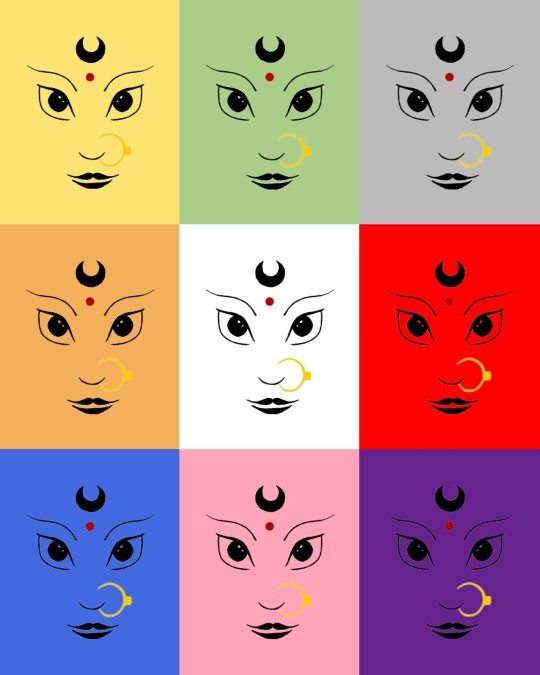
The tenth day of Navaratri celebrates all of Durga's victories over the past nine nights. Jai Durga Maa!
It is a tradition in some parts to commemorate the weapons and tools that brought Durga victory and triumph over all she faced, and too, pay homage to our own weapons, magickal or otherwise, and tools of trade that bring us victory in our own lives.
©️Sagans Sorcery 🔥🖋️
---
I have been posting each of her forms for each day during the festival on my Facebook page: facebook.com/SaganOakes
When I don't post on here I'm always posting there if you want to check it out 💙☄️
Thank you so much for reading ✨🙏✨ Much love.
While this article and the very last image I have used is written and created by myself @saganssorcery, the rest of the images I have found on the web. If you are the original creator(s) and wish for me to remove an image please send me a DM and I will remove it as soon as I see the message. Thank you 💙☄️
#durga#navaratri#spiritually#sagans sorcery#sorcery#sorceress#magick#occultism#occult#occult art#chaos witch#chaos magician#chaos magic#ceremonial magic#hindu art#hindu mythology#mythology#goddess durga#goddess worship#gods and goddesses#goddess#deity work#deity#deity worship#pantheon#witch#witchcraft#witch community#witchblr#witches of tumblr
19 notes
·
View notes
Text
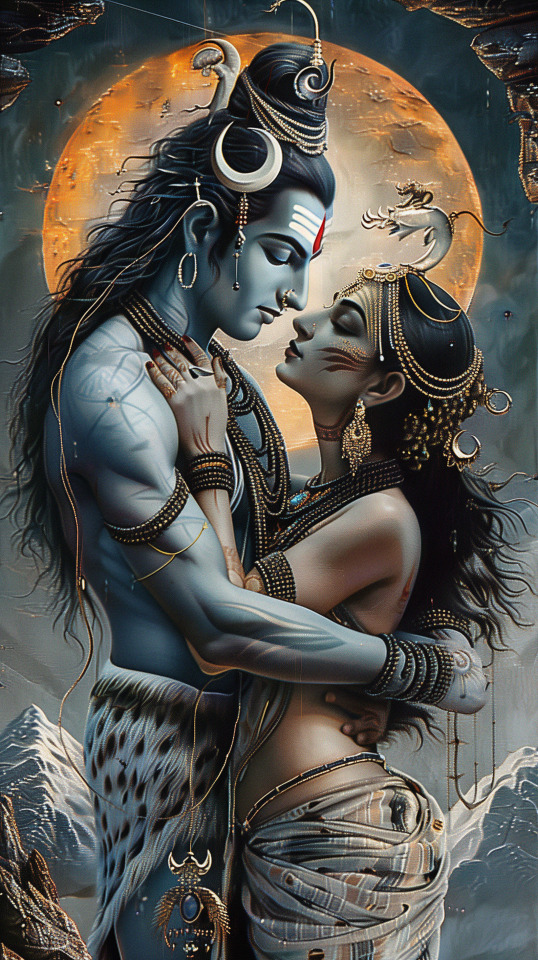
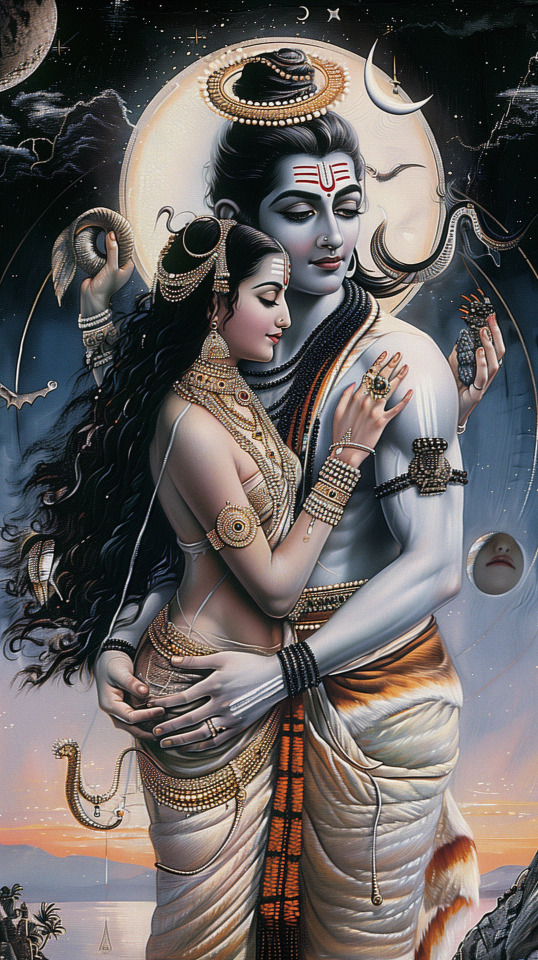
Shiva and Shakti - The Divine Union of Consciousness and Energy
In the Tantric cosmology, the whole universe is perceived as being created, penetrated and sustained by two fundamental forces, which are permanently in a perfect, indestructible union. These forces or universal aspects are called Shiva and Shakti.
The tradition has associated to these principles a form, respectively that of a masculine deity and that of a feminine one. Accordingly, Lord Shiva represents the constitutive elements of the universe, while Shakti is the dynamic potency, which makes these elements come to life and act.
From a metaphysical point of view, the divine couple Shiva-Shakti corresponds to two essential aspects of the One: the masculine principle, which represents the abiding aspect of God, and the feminine principle, which represents Its Energy, the Force which acts in the manifested world and life itself.
Shakti here stands for the immanent aspect of the Divine, that is the act of active participation in the act of creation. This Tantric view of the Feminine in creation contributed to the orientation of the human being towards the active principles of the universe, rather than towards those of pure transcendence.
Therefore, Shiva defines the traits specific to pure transcendence and is normally associated, from this point of view, to a manifestation of Shakti who is somewhat stronger (such as Kali and Durga), personification of Her own untamed and limitless manifestation.
Owing to the fact that in a way, Shakti is more accessible to the human understanding (because this regards aspects of life that are closely related to the human condition inside the creation), the cult of the Goddess (DEVI) has spread more forcibly.
Shaktism on Shiva and Shakti
Shaktism’s focus on the Divine Feminine does not imply a rejection of Masculine or Neuter divinity. However, both are deemed to be inactive in the absence of Shakti. As set out in the first line of Adi Shankara’s renowned Shakta hymn, Saundaryalahari (c. 800 CE): “If Shiva is united with Shakti, he is able to create. If he is not, he is incapable even of stirring.” This is the fundamental tenet of Shaktism, as emphasized in the widely known image of the goddess Kali striding atop the seemingly lifeless body of Shiva.
Broadly speaking, Shakti is considered to be the cosmos itself – she is the embodiment of energy and dynamism, and the motivating force behind all action and existence in the material universe. Shiva is her transcendent masculine aspect, providing the divine ground of all being. “There is no Shiva without Shakti, or Shakti without Shiva. The two […] in themselves are One”.
The 5 Powers of Shakti
There are many aspects, forms and names of shakti who is the mother of all. In creation she distinguishes herself, or through the will of Siva, into three basic aspects:
para-shakti (transcendental energy),
apara-shakti (immanent energy) and
para-apara-shakti ( an intermediary energy).
In the texts of Shaivism we also find a reference to five supernatural powers of shakti, awakened in himself by Siva. Their permutation, combination, concealment and manifestation is believed to be responsible for the multiplicity, plurality, diversity and duality of the beings and objects and their forms and shapes in the manifested worlds. The five aspects of shakti manifested by Siva are:
chit-shakti or the power of consciousness,
anada-shakti or the power of bliss consciousness,
iccha-shakti, the power of desire or will,
kriya-shakti the power of action and
jnana-shakti or the power of knowledge
Siva unleashes these five powers in the beginning of creation and withdraws them back into himself at the time of dissolution. In between he employs these energies for the purposes of creation (srishti), preservation (sthithi), samhara (destruction or modification), concealment (tirobhava) and revelation (anugraha).
Shiva Shakti Story
The legend of the marriage of Shiva and Shakti is one the most important legends related to the festival of Mahashivaratri. The story tells us how Lord Shiva got married for the second time to Shakti, his divine consort. According to legend of Shiva and Shakti, the day Lord Shiva got married to Parvati is celebrated as Shivaratri – the Night of Lord Shiva.
The Legend goes that once Lord Shiva and his wife Sati or Shakti were returning from sage Agastya’s ashram after listening to Ram Katha or story of Ram. On their way through a forest, Shiva saw Lord Rama searching for his wife Sita who had been kidnapped by Ravana, the King of Lanka. Lord Shiva bowed his head in reverence to Lord Rama. Sati was surprised by Lord Shiva’s behavior and inquired why he was paying obeisance to a mere mortal. Shiva informed Sati that Rama was an incarnation of Lord Vishnu. Sati, however, was not satisfied with the reply and Lord asked her to go and verify the truth for herself.
Using her power to change forms, Sati took the form of Sita appeared before Rama. Lord Rama immediately recognized the true identity of the Goddess and asked, “Devi, why are you alone, where′s Shiva?” At this, Sati realized the truth about Lord Ram. But, Sita was like a mother to Lord Shiva and since Sati took the form of Sita her status had changed. From that time, Shiva detached himself from her as a wife. Sati was sad with the change of attitude of Lord Shiva but she stayed on at Mount Kailash, the abode of Lord Shiva.
Later, Sati’s father Daksha organised a yagna, but did not invite Sati or Shiva as he had an altercation with Shiva in the court of Brahma. But, Sati who wanted to attend the Yagna, went there even though Lord Shiva did not appreciate the idea. To her great anguish, Daksha ignored her presence and did not even offer Prasad for Shiva. Sati felt humiliated and was struck with profound grief. She jumped into the yagna fire and immolated herself.
Lord Shiva became extremely furious when he heard the news of Sati’s immolation. Carrying the body of Sati, Shiva began to perform Rudra Tandava or the dance of destruction and wiped out the kingdom of Daksha. Everybody was terrified as Shiva’s Tandava had the power to destroy the entire universe. In order to calm Lord Shiva, Vishnu severed Sati′s body into 12 pieces and threw them on earth. It is said that wherever the pieces of Shakti’s body fell, there emerged a Shakti Peetha, including the Kamaroopa Kamakhya in Assam and the Vindhyavasini in UP.
Lord Shiva who was now alone, undertook rigorous penance and retired to the Himalayas. Shakti took a re-birth as Parvati in the family of God Himalaya. She performed penance to break Shiva’s meditation and win his attention. It is said that Goddess Parvati found it hard to break Shiva’s meditation but through her devotion and the persuasion by sages and devas, Parvati, also known as Uma, was finally able to lure Shiva into marriage and away from asceticism. Their marriage was solemnized a day before Amavasya in the month of Phalgun. This day of union of God Shiva and Shakti is celebrated as Mahashivratri every year.
There is no Shiva without Shakti and yoga is a realization of the unity of all things. That is not to say that everything in tantrik texts is figurative; many describe practices which are said to bring about this realization.
Shiva Shakti Mantras
Shiva Shakti Panchakshari Mantra
“Om Hrim Namah Shivaya”
Important Shiva Shakti Mantra
(i) “Om Shiva Om Shakti”
(ii) “Namah Shiva Namah Shakti”
(iii) “Om Sarva Mangal Mangaley Shivay Sarvarth Sadhike
Sharanye Trambhake Gauri Narayani Namostutey”
Therefore, Shakti is the dynamic power of Siva through which he manifests the worlds and their myriad objects and beings. He brings forth the worlds and their beings through his will and his dynamic energy, Shakti.
Art – Shiva & Shakti by Talon Abraxas
22 notes
·
View notes
Text
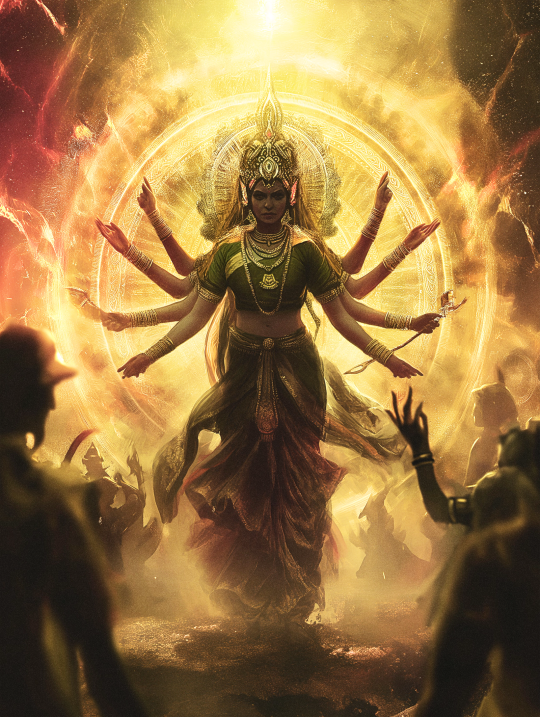
Maa Durga
Durga, in Hinduism, a principal form of the Goddess, also known as Devi and Shakti.
Happy Chaitra Navratri 2024!
Happy Chaitra Navratri 2024: The nine-day festival of Chaitra Navratri falls on April 9 this year. It will end with Ram Navami celebrations on April 17. Chaitra Navratri begins on the first day of the Hindu Luni-Solar calendar. Devotees worship Maa Durga and her nine incarnations - Maa Shailputri, Maa Brahmacharini, Maa Chandraghanta, Maa Kushmanda, Skanda Mata, Maa Katyayani, Maa Kaalratri, Maa Mahagauri and Maa Siddhidatri - on this day. They also worship Lord Ram on Ram Navami and celebrate his birth. --Krishna Priya Pallavi, Hindustani Times
26 notes
·
View notes
Text
Day nine of Navratri
9 days, 9 Godesses

Day nine : Siddhidatri | सिद्धिदात्री
Purest form of energy
Siddhadhatri is pure energy-the first and purest form of energy. Modern science has only recently understood the concept of pure energy! She was formless but Shiva supplicated her and she became Adi Shakti. In her Parvati attained her supreme form as a complete manifestation of Mahashakti or the primeval power.
Siddhi means supernatural power and dhatri means the giver. So she is the sole source of all power-both material and spiritual. She is capable of giving us all the eight siddhis-ashta siddhis or supernormal powers.
Mantra for the day:
ॐ देवी सिद्धिदात्र्यै नमः ॥ "Aum Devi Siddhidhatrayai Namaha!"
Jai Maa Durga 🔱
41 notes
·
View notes
Text
Maa Shailputri: The Divine Goddess of Strength, Wisdom & New Beginnings
Hindu mythology celebrates Maa Shailputri as the first form of Goddess Durga, honored on the initial day of Navratri. She embodies strength, purity, and unwavering determination, offering her devotees guidance toward stability and spiritual enlightenment. But who is Shailputri Mata, and why does she hold such an important place in Hinduism? Let’s explore the divine presence of Shailputri Maa and how her blessings can bring prosperity and peace into our lives.
The Significance of Shailputri Maa
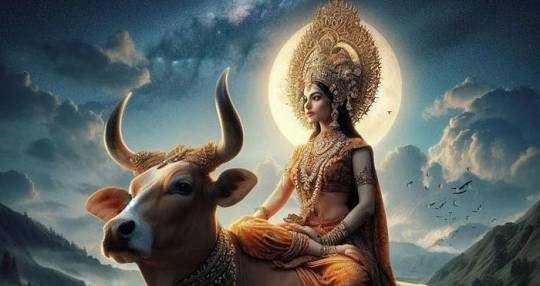
The name Shailputri translates to "Daughter of the Mountains," as she was born as the daughter of King Himalaya. In her previous life, she was Goddess Sati, who sacrificed herself in the yajna fire. Reincarnated as Mata Shailputri, she represents fresh beginnings, resilience, and unwavering devotion.
Portrayed riding a sacred bull while holding a trident and a lotus, Shailputri Maa is connected to the earth element, bringing her followers stability, protection, and spiritual strength.
To learn more about her significance and divine powers, visit this detailed guide.
Why is Worshipping Mata Shailputri Important?
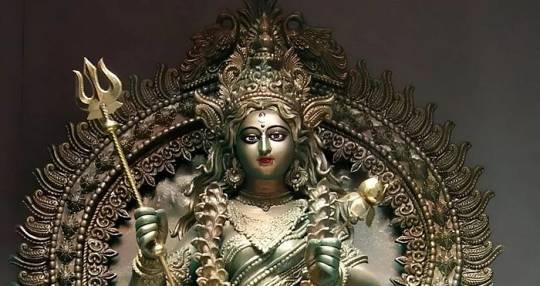
Devotees worship Mata Shailputri to receive her divine protection, strength, and wisdom. She governs the Muladhara Chakra (Root Chakra), which is responsible for grounding and emotional balance in one’s life.
Major Benefits of Worshipping Shailputri Maa:
Removes Life’s Obstacles: Helps clear negativity and challenges.
Ensures Emotional Stability: Brings peace and mental clarity.
Aids in Spiritual Development: Supports meditation and inner discipline.
Promotes Good Health: Strengthens immunity and overall well-being.
Enhances Confidence & Determination: Provides courage to overcome struggles.
By offering sincere prayers and chanting mantras dedicated to Maa Shailputri, devotees can invite prosperity and divine guidance into their lives.
How to Perform Puja for Shailputri Mata?
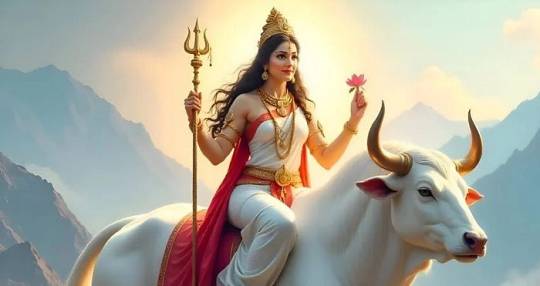
Performing a sacred puja for Shailputri Mata with true devotion is believed to bring immense blessings. Here’s how you can conduct the rituals:
Auspicious Day: She is worshipped on the first day of Navratri.
Offerings: White flowers, cow’s milk, and pure ghee are considered sacred for her worship.
Mantra for Divine Blessings: Recite "ॐ देवी शैलपुत्र्यै नमः" (Om Devi Shailputryai Namah) for protection and peace.
Observing Fast: Devotees keep a fast to purify the mind and seek divine grace.
By following these rituals with faith, one can experience the divine presence of Shailputri Mata and receive her celestial blessings.
Astrological Influence of Shailputri Mata

Astrologically, Mata Shailputri is linked to the Moon, which governs emotions, mental clarity, and intuition. Those experiencing emotional distress, anxiety, or confusion can seek her divine guidance to restore inner peace and balance.
To understand her impact on astrology and remedies for aligning with her energy, visit AstrologyStarts for deeper insights.
Final Thoughts: Why Should You Worship Shailputri Maa?
Worshipping Shailputri Mata is not just a spiritual practice—it’s a way to embrace her strength, wisdom, and divine protection in our lives. Whether you seek stability, success, or spiritual growth, her grace can guide you toward the right path.
To explore more about Maa Shailputri and her divine blessings, check out this detailed guide. May her blessings bring peace, prosperity, and positivity into your life!
2 notes
·
View notes
Text

Devi (1960, India)
One year following his stunning Apur Sansar (The World of Apu) (1959), director Satyajit Ray reunited actors Sharmila Tagore and Soumitra Chatterjee. By this point, Ray was no longer the studious yet inexperienced hand that shepherded the Apu trilogy to its conclusion. But his lead actors were still only starring in their second-ever film. Bengali cinema (Tollywood, based in West Bengal) had a proud history before Ray’s Apu trilogy (1955-1959), but now had caught the attention of audiences beyond India – disproportionately so, as Bollywood (Hindi cinema, based in Mumbai) has always been the largest part of the nation’s film industry. Unlike some of the most popular Tollywood and Bollywood films of the time (and now), Ray never showed interest in romantic-musical escapism and instead dared to make films challenging India’s caste system, sexism, and religious fanaticism.
In his first work addressing religious fanaticism (and arguably his first truly political film) comes Devi, also known by its English-language title as The Goddess. Unlike 1965’s Mahapurush (The Holy Man), which also covers the same topic, Devi is thoroughly a drama, with no hint of comedy or satire. The film’s somber tone did not sit well with general Indian audiences used to lighter fare, and its willingness to criticize the extremes of Hindu religiosity saw the film’s harshest critics deem it (and Ray) as anti-Hindu. If released today, Devi almost certainly would receive a similar, if not more intense, backlash from groups and individuals in India criticizing it out of bad faith.
Somewhere in a rural town in nineteenth century Bengal, younger brother Umaprasad (Soumitra Chatterjee) is ready to depart for Kolkata for university and to study English. Umaprasad’s family is wealthy, with numerous servants tending to their multistory mansion. All is well in their richly-furnished, well-kempt home as he leaves his teenage* wife Dayamayee‡ (Sharmila Tagore) to take of his aging father/her father-in-law Kalikinkar Choudhuri (Chhabi Biswas). One night, Kalinikar awakens from a marvelous dream. An adherent of the goddess Kali, his visions lead him to believe that his daughter-in-law is Kali’s physical incarnation. Upon awakening, he rushes to Dayamayee and falls to his feet in worship. Dayamayee’s life as Umaprasad’s wife has ended. Against her will, she becomes an object of religious devotion as word spreads of Kalikinkar’s dream and a supposed miracle shortly thereafter.
Devi also stars Purnendu Mukherjee as Umaprasad’s brother, Taraprasad; Karuna Banerjee as Harasundari, Taraprasad’s wife; and Arpan Chowdhury as Taraprasad and Harasundari’s son (Dayamayee’s nephew).
Where a year prior Apur Sansar was Soumitra Chatterjee’s movie, Devi is likewise Sharmila Tagore’s. Tagore, sixteen years old upon the film’s release year, again finds herself in a role with little dialogue, even less than her supporting role in Apur Sansar. The moment Tagore’s Dayamayee becomes a devotional figure, her dialogue and ability to exert her own agency disappears. Until Umaprasad returns home shortly after the halfway mark, so much of Tagore’s performance before and after seems spliced from a great silent film. Perched on a small block, a pedestal if you will, she almost never looks at the camera or those intoning “Mā” (“Mother” in Bengali; Kali is the avatar of Durga, and both are forms of the Mother Goddess, Devi) as men and women pray and prostrate themselves in front of her. At times, Dayamayee’s mental and physical exhaustion is clear, even if she is looking sideways or into the ground, as she sits in place for several hours at a time. Is there any one there to make sure that this “goddess” is properly being taken care of? It seems doubtful.
It is unclear how long it takes for word to reach Umaprasad in order for him to return home to see the daily scenes at his family’s residence. Even for less than a day, this whole situation is intolerable to Dayamayee. Her resignation is evident in her slightly hunched back, unable to find a psychological or physical escape. The scene where Umaprasad returns home to see Dayamayee venerated as a goddess contains striking facial acting from both Tagore and Chatterjee. In Chatterjee, we see Umaprasad comprehending the situation in real time, as his horror renders him almost speechless. In Tagore, Dayamayee looks up, and in a figment of hope, there is utter heartbreak. These long days of adoration and miracle-seeking pilgrims have even shaken her sense of reality, as almost all vestiges of her past life wither away. In a rare private moment with Umaprasad, she questions her very being: “But what if I am a goddess?”
Satyajit Ray, who also wrote this screenplay based on the 1899 Bengali short story of the same name by Prabhat Kumar Mukhopadhyay, was part of the Brahmo Samaj movement, which advocates for a monotheistic interpretation of Hinduism. Brahmos, crucially, reject the caste system and avatars/incarnations of gods and goddesses. Ray’s adherence to the reforms of Brahmo Samaj color his filmography more obviously as his career progresses (I have not seen too much of Ray’s work, but I have not yet encountered a film of his that inelegantly portrayed his beliefs). Ray’s reformist and Western-leaning stances are embodied by Chatterjee’s Umaprasad, who we see clash with his more traditional father over social mores (the latter is distrustful of his son’s education, and derides his son for supposedly espousing Christian beliefs). Except for the scenes of a religious procession immediately after the opening credits, at no point does Ray imbue any of the religious images with any sense of glory, wonder, or veneration. Cinematographer Subrata Mitra (the Apu trilogy, 1966’s Nayak) dispenses of any ethereal lighting until the closing seconds, and his medium to close shots capture the uncomfortable anguish on both sides – Dayamayee’s alternating ambivalence and despair, the worshippers��� desire for comfort, deliverance, and the miraculous.
Like in several of Ray’s films including Mahapurush and Ganashatru (An Enemy of the People) (1989), Devi rejects dogmatism, miracles, superstitions, and anything that cannot have a rational or scientific explanation. Simultaneously, Ray realizes that most Indians, in the face of events profound and improbable, find science and rationality cold, confusing, and unsatisfying. Faith endows meaning to such moments. Faith ascribes purpose to happiness and suffering – something rationalism cannot provide. The unsuitability of both to provide a solution in Devi is the film’s secondary tragedy, as belief systems confront a scenario where a middle ground is impossible.
Devi’s principal tragedy is the religious objectification of Dayamayee. Of all of Ray’s female protagonists from Pather Panchali (1955) to this point, none of them are as constrained as Tagore’s Dayamayee. She may not live in poverty like Apu’s sister and mother in the Apu trilogy, nor is she the wife of an indulgent husband (1958’s Jalsāghar or The Music Room). And though she is not bound by shackles or subject to physical or sexual abuse, Dayamayee is nevertheless a victim of the unpredictable whims of men (and it is almost entirely men who worship her). Her portrayal is nuanced: she does not succumb entirely to self-pity, nor does she possess the strength to tell her father-in-law and his fellow worshippers to halt their devotional displays. She is aware of the communal damage she will cause if she so much renounces her unwanted divinity. At the same time, she cannot help but yearn for freedom, for others to speak to her like a human again – complete with aspirations, desires, and fears that no one can associate with a god.
Too often in cinema – wherever and whenever it hails from, including midcentury India – women play simplistic roles: the lover, the damsel in distress, the spurned wife. Where numerous filmmakers and actresses in the Hollywood Studio System were actively working to dismantle this element of patriarchy, I do not detect a similar level of rebellion in mainstream Indian cinema in the 1950s and 1960s (and, to some extent, this remains true). Ray did not stand alone in attempting to endow female characters with complexity (within and outside Bengali cinema), but his contributions to this development within the context of midcentury Indian cinema are crucial. Many of his films attempt a cinematic dialogue that critiqued patriarchal abuses with subtlety and bluntness – often to the chagrin of the public and government officials. The public outrage following Devi’s initial domestic release saw the film banned from seeking international distribution. Prime Minister Jawaharlal Nehru intervened and reversed that decision.
Nevertheless, consider some of the works in Ray’s first decade as a filmmaker: The Apu trilogy, Devi, Teen Kanya (1961), The Big City (1963), and Charulata (1964). Together, all seven of those films reveal a filmmaker willing to take mainstream Indian filmmaking to task for regressive and simplistic portrayals of women, whether in lead or supporting roles. Devi might be the most shattering of that collection, caught between human weakness and the unknowability of the divine.
My rating: 8.5/10
^ Based on my personal imdb rating. My interpretation of that ratings system can be found in the “Ratings system” page on my blog. Half-points are always rounded down.
For more of my reviews tagged “My Movie Odyssey”, check out the tag of the same name on my blog.
* There were no child marriage laws in India in the nineteenth century, when this film is set. Child marriage remains prevalent in India, despite loophole-filled laws and a lack of enforcement.
‡ Multiple spellings of the protagonist's name are out there from reputable sources. I am using either the most or second-most common spelling here.
#Devi#The Goddess#Satyajit Ray#Sharmila Tagore#Soumitra Chatterjee#Chhabi Biswas#Purnendu Mukherjee#Karuna Banerjee#Arpan Chowdhury#Anil Chatterjee#Subrata Mitra#Dulal Dutta#Ustad Ali Akbar Khan#Bengali cinema#TCM#My Movie Odyssey
6 notes
·
View notes
Text
The Apu Trilogy

Subir Banerjee in Pather Panchali (Satyajit Ray, 1955)
Cast: Kanu Bannerjee, Karuna Bannerjee, Chunibala Devi, Uma Das Gupta, Subir Banerjee, Runki Banerjee, Reba Devi, Aparna Devi, Tulsi Chakraborty. Screenplay: Satyajit Ray, based on a novel by Bibhutibhushan Bandyopadhyay. Cinematography: Subrata Mitra. Production design: Bansi Chandragupta. Film editing: Dulal Dutta. Music: Ravi Shankar.
When I first saw Pather Panchali I was in my early 20s and unprepared for anything so foreign to my experience either in life or in movies. And as is usual at that age, my response was to mock. So half a century passed, and when I saw it again both the world and I had changed. I now regard it as a transformative experience -- even for one whom the years have transformed. What it shows us is both alien and familiar, and I wonder how I could have missed its resonance with my own childhood: the significance of family, the problems consequent on adherence to a social code, the universal effect of wonder and fear of the unknown, the necessity of art, and so on. Central to it all is Ray's vision of the subject matter and the essential participation of Ravi Shankar's music and Subrata Mitra's cinematography. And of course the extraordinary performances: Kanu Bannerjee as the feckless, deluded father, clinging to a role no longer relevant in his world; Karuna Bannerjee as the long-suffering mother; Uma Das Gupta as Durga, the fated, slightly rebellious daughter; the fascinating Chunibala Devi as the aged "Auntie"; and 8-year-old Subir Banerjee as the wide-eyed Apu. It's still not an immediately accessible film, even for sophisticated Western viewers, but it will always be an essential one, not only as a landmark in the history of movie-making but also as an eye-opening human document of the sort that these fractious times need more than ever.

Smaran Ghosal in Aparajito (Satyajit Ray, 1956)
Cast: Pinaki Sengupta, Smaran Ghosal, Kanu Bannerjee, Karuna Bannerjee, Ramani Sengupta, Charuprakash Ghosh, Subodh Ganguli. Screenplay: Satayajit Ray, Kanaili Basu, based on a novel by Bibhutibhushan Bandyopadhyay. Cinematography: Subrata Mitra. Production design: Bansi Chandragupta. Film editing: Dulal Dutta. Music: Ravi Shankar
As the middle film of a trilogy, Aparajito could have been merely transitional -- think for example of the middle film in The Lord of the Rings trilogy: The Two Towers (Peter Jackson, 2002), which lacks both the tension of a story forming and the release of one ending. But Ray's film stands by itself, as one of the great films about adolescence, that coming-together of a personality. The "Apu trilogy," like its source, the novels by Bibhutibhushan Bandyopadhyay, is a Bildungsroman, a novel of ... well, the German Bildung can be translated as "education" or "development" or even "personal growth." In Aparajito, the boy Apu (Pinaki Sengupta) sprouts into the adolescent Apu (Smaran Ghosal), as his family moves from their Bengal village to the city of Benares (Varanasi), where Apu's father continues to work as a priest, while his mother supplements their income as a maid and cook in their apartment house. When his father dies, Apu and his mother move to the village Mansapota, where she works for her uncle and Apu begins to train to follow his father's profession of priest. But the ever-restless Apu persuades his mother to let him attend the village school, where he excels, eventually winning a scholarship to study in Calcutta. In Pather Panchali (1955), the distant train was a symbol for Apu and his sister, Durga, of a world outside; now Apu takes a train into that world, not without the painful but necessary break with his mother. Karuna Bannerjee's portrayal of the mother's heartbreak as she releases her son into the world is unforgettable. Whereas Pather Panchali clung to a limited setting, the decaying home and village of Apu's childhood, the richness of Aparajito lies in its use of various settings: the steep stairs that Apu's father descends and ascends to practice his priestly duties on the Benares riverfront, the isolated village of Mansapota, and the crowded streets of Kolkata, all of them magnificently captured by Subrata Mitra's cinematogaphy.

Soumitra Chatterjee in The World of Apu (Satyajit Ray, 1959)
Cast: Soumitra Chatterjee, Sharmila Tagore, Swapan Mukherjee, Alok Chakravarty, Dhiresh Majumdar, Dhiren Ghosh. Screenplay: Satyajit Ray, based on a novel by Bibhutibhushan Bandyopadhyay. Cinematography: Subrata Mitra. Production design: Bansi Chandragupta. Film editing: Dulal Dutta. Music: Ravi Shankar.
The exquisite conclusion to Ray's trilogy takes Apu (Soumitra Chatterjee) into manhood. He leaves school, unable to afford to continue into university, and begins to support himself by tutoring while trying to write a novel. When his friend Pulu (Swapan Mukherjee) persuades him to go along to the wedding of his cousin, Aparna (Sharmila Tagore), Apu finds himself marrying her: The intended bridegroom turns out to be insane, and when her father and the other villagers insist that the astrological signs indicate that Aparna must marry someone, Apu, the only available male, is persuaded, even though he regards the whole situation as nonsensical superstition, to take on the role of bridegroom. (It's a tribute to both the director and the actors that this plot turn makes complete sense in the context of the film.) After a wonderfully awkward scene in which Apu and Aparna meet for the first time, and another in which Aparna, who has been raised in comparative luxury, comes to terms with the reality of Apu's one-room apartment, the two fall deeply in love. But having returned to her family home for a visit, Aparna dies in childbirth. Apu refuses to see his son, Kajal (Alok Chakravarty), blaming him for Aparna's death and leaving him in the care of the boy's grandfather. He spends the next five years wandering, working for a while in a coal mine, until Pulu finds him and persuades him to see the child. As with Pather Panchali and Aparajito, The World of Apu (aka Apur Sansar) stands alone, its story complete in itself. But it also works beautifully as part of a trilogy. Apu's story often echoes that of his own father, whose desire to become a writer sometimes set him at odds with his family. When, in Pather Panchali, Apu's father returns from a long absence to find his daughter dead and his ancestral home in ruins, he burns the manuscripts of the plays he had tried to write. Apu, during his wanderings after Aparna's death, flings the manuscript of the novel he had been writing to the winds. And just as the railroad train figures as a symbol of the wider world in Pather Panchali, and as the means to escape into it in Aparajito, it plays a role in The World of Apu. Instead of being a remote entity, it's present in Apu's own back yard: His Calcutta apartment looks out onto the railyards of the city. Adjusting to life with Apu, Aparna at one point has to cover her ears at the whistle of a train. Apu's last sight of her is as she boards a train to visit her family. And when he reunites with his son, he tries to play with the boy and a model train engine. The glory of this film is that it has a "happy ending" that is, unlike most of them, completely earned and doesn't fall into false sentiment. I don't use the world "masterpiece" lightly, but The World of Apu, both alone and with its companion films, seems to me to merit it.
4 notes
·
View notes
Text
The Kaênaasthan Pantheon Series
Part 1: The PrótaDevi
Vada (Greetings)! Welcome to my Kaênaasthan Pantheon Series. In this series I will be outlining the Devis (Gods) in the Kaênaasthan Pantheon; their domains, affiliations, and what is sacred to them.
Today we will be starting with the 3 PrótaDevi - The First Generation of Devis.
Gaia-Shakti
Domain & Title: Mother Earth & Devi of Nature Body Part: Feet Element: Earth Planet: Earth Sacred Colors: Blue, Green, Brown, Gold Sacred Flowers: Chrysanthemums Sacred Animals: Cows, Lions Food: Garden Foods Syncretisms: Demeter, Gaia, Shakti Symbol: ⊕
Gaia-Shakti was the first Devi in all of creation, she is the mother of all Devis and because of this holds the title of MahaDevi. Gaia-Shakti is the personification of the planet Earth and the natural world.
She had two consorts, Ouranos and Pontoris-Varuna, and brought into existence a total of 6 Devis with them.
With Ouranos, Shakti brought into existence Cybele-Durga, Phoibê-Sarasvati, Kronos-Brahma, Koios, and Kriôs; and with Pontoris-Varuna she conceived and gave birth to Amiatê-Varuni.
Pontoris-Varuna
Planet: Neptune Element: Water Domain & Title: Devi of the Inhospitable Sea Sacred Colors: Blue, Grey, Black Syncretisms: Dôris, Pontus, Poseidon, Varuna Symbol: ꩜
Pontoris-Varuna was the second Devi in existence. He was the personification of the oceans at the dawn of creation, before there were organisms living in the sea.
In the Kaênaasthan Creation Myth (Shurūchí Samay aur Génnisi Devi) Pontoris-Varuna worked alongside Ouranos in an attempt to prevent new life forming on Earth. He then saw the error in his ways and moved to join the Devis fight against Ouranos.
His consort was Gaia-Shakti - with her he had one daughter, Amiatê-Varuni, whom he gave up his life and domain to protect.
Pontoris-Varuna is not considered a living deity and is not actively worshipped in Kaênaastha.
Ouranos
Planet: Saturn Element: Air Domain & Title: Devi of the Inhospitable Sky Sacred Colors: White, Grey, Black Syncretisms: Brahma, Ouranos Symbol: ☁︎
Ouranos was the third Devi in existence. He was the personification of the sky at the dawn of creation, before there were organisms living on land.
In the Kaênaasthan Creation Myth - Ouranos, with the help of Pontoris-Varuna, worked to prevent new life forming on Earth. Even when Pontoris-Varuna abandoned this effort, Ouranos continued to rule the skies as a tyrant until he was defeated by the progeny of Cybele-Durga and Kronos-Brahma - Jupiter-Brihaspati.
His consort was Gaia-Shakti - together the two brought into existence five Devis: Cybele-Durga, Phoibê-Sarasvati, Kronos-Brahma, Koios, and Kriôs.
Ouranos is also the father of the Devi Aphroditê-Kamakshi - who was created from Ouranos' severed penis after his death.
Ouranos is not considered a living deity and is not actively worshipped in Kaênaastha.
Want to learn more about Kaênaastha? Check out the hashtag or reach out via the askbox - anonymous asks welcome!
As It Was - As It Is - As It Shall Be
~||~
#witchblr#paganblr#witch#pagan#Kaenaasthan#Kaênaasthan#Kaênaastha#kaenaastha#The Kaênaasthan Pantheon Series#spirituality#the witch Farhan#thewitchfarhan#helpol#Hinduism
2 notes
·
View notes
Text
Difference between Chaitra Navratri and Sharad Navratri
Reading time- 5 mins
India, a land of diverse cultures and traditions, celebrates Navratri not once, but twice a year with great enthusiasm and devotion. Navratri, meaning 'nine nights,' is a Hindu festival dedicated to Goddess Durga and her various forms. These two celebrations, Chaitra Navratri and Sharad Navratri, hold unique significance and are observed at different times of the year. In this blog, we'll explore why Navratri is celebrated twice in India and delve into the captivating mythological stories behind the divine forms of Maa Durga.
Chaitra Navratri: Welcoming Spring
Chaitra Navratri falls in the Chaitra month of the Hindu calendar, typically in March or April. This festival marks the beginning of spring when nature awakens, and new life blossoms. During these nine days, devotees pay homage to Goddess Durga and seek her blessings for prosperity and good fortune.
Chaitra Navratri is believed to commemorate the day when Lord Rama, accompanied by his brother Lakshmana and devotee Hanuman, worshiped Goddess Durga to seek her blessings before embarking on his epic journey to rescue his wife, Sita, from the demon king Ravana. It symbolizes the victory of good over evil and the triumph of righteousness. The culmination of Chaitra Navratri is celebrated as Ram Navami.
Sharad Navratri: Celebration of the Harvest
Sharad Navratri, also known as Maha Navratri, is the more widely celebrated of the two. It falls in the lunar month of Ashwin, usually in September or October when the monsoon season ends and the country gears up for the harvest season. This grand festival celebrates the divine feminine and the goddess's prowess in defeating the buffalo demon, Mahishasura.
According to Hindu mythology, Mahishasura was a formidable demon who terrorized the gods. He received a boon from Lord Agni, according to which a woman would only kill him. Unable to defeat him, the gods created Goddess Durga, a symbol of ultimate feminine power. Durga fought Mahishasura for nine days and nights, ultimately slaying him on the tenth day, known as Vijayadashami or Dussehra. Sharad Navratri symbolizes the victory of good over evil, knowledge over ignorance, and light over darkness. It is the ultimate celebration of divine female energies.
Young girls all over India are worshipped as devotees who believe that the Devi resides in little girls.
Maa Durga is depicted in 9 various forms, each with its own significance and attributes, to defeat the shape-shifting demon: Mahishasura. During Navratri, these forms are celebrated on specific days, known as 'Navadurga.' Let's explore some of the most renowned forms:
Shailaputri: The first form of Durga, she is the daughter of the Himalayas and represents the purity and innocence of nature.
Brahmacharini: She symbolizes the pursuit of knowledge and is often depicted holding a rosary and a water pot.
Chandraghanta: This form represents bravery and courage, as she adorns a crescent moon-shaped ornament on her forehead.
Kushmanda: The creator of the universe, Kushmanda signifies the source of all energy and vitality.
Skandamata: As the mother of Lord Kartikeya, she stands for the power of a mother's love and protection.
Katyayani: This fierce form of Durga is worshiped for her ability to destroy evil forces and protect her devotees.
Kalratri: Depicting the dark side of life, she is a symbol of destruction and liberation from ignorance.
Mahagauri: This form represents purity and is often depicted in white attire, symbolizing peace and serenity.
Siddhidatri: The final form of Durga, Siddhidatri is believed to grant devotees spiritual powers and enlightenment.
Navratri is a spiritually enriching festival that honors the divine feminine. Whether it's the arrival of spring during Chaitra Navratri or the harvest season of Sharad Navratri, both celebrations remind us of the importance of faith, perseverance, and the victory of good over evil. The diverse forms of Maa Durga teach us valuable life lessons and inspire us to live virtuously.
Gujratis celebrate Navratri through vibrant Garba and Dandiya Raas dances, while in Bengal, this festival is celebrated as Durga Puja, which involves worshiping the goddess Durga with grand processions and cultural events. So, they celebrate Navratri, but how it's celebrated varies.
This Navaratri, bring home the divine presence of Goddess Durga with the Navaratri-Durga Puja Kit from Prabhu Shriram- Incense with a Story.
This pack contains-
Mata Vaishno Devi Agarbatti
Upasana Dhoop
Sambrani Cups
Havan Samagri
Divya Jyot
Mauli Dhaga
Guggal Loban
Jau
Pavitra Ganga Sand Soil
Red Cloth
Mata Chunri
Laung
Supari
Sindoor/Roli
Haldi
Akshat
Mishri/Kaju/Kishmish/Elaichi
Camphor
2 notes
·
View notes
Text
History of Madhubani Painting
Madhubani painting, also known as Mithila painting, is one of the most celebrated traditional art forms of India. Originating from the Mithila region of Bihar and Nepal, this vibrant folk art has transitioned from being a ritualistic expression on mud walls to a globally recognized form of cultural storytelling on paper and canvas. Deeply rooted in history, Madhubani art is not just a form of decoration; it is a visual language that has preserved the stories, traditions, and spiritual beliefs of a community for centuries.
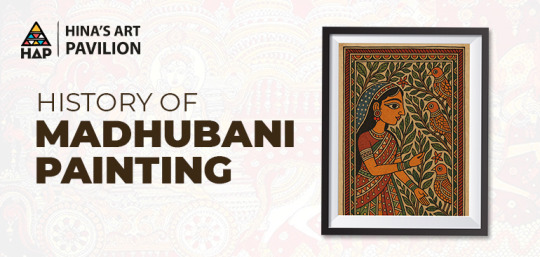
Where Did Madhubani Painting Originate?
Madhubani painting finds its origin in the Mithila region, particularly in the villages of Bihar. The term “Madhubani” means “forest of honey” and the style is believed to date back to the Ramayana period, when King Janaka asked artists to create murals to celebrate the wedding of his daughter Sita to Lord Rama. Traditionally, women painted Madhubani art on the walls of their homes to mark festivals, religious events, and rites of passage like marriage or childbirth.
What Is the Historical Significance of Madhubani Painting?
Historically, Madhubani art was created using natural dyes and pigments on freshly plastered mud walls. The art form was passed down through generations, primarily among women in the Mithila region. Each artwork held religious or cultural symbolism and was often inspired by mythology, nature, and folklore. The themes usually revolved around Hindu gods and goddesses like Krishna, Shiva, Durga, and Lakshmi, as well as sun, moon, sacred plants like tulsi, and animals.
During the 1960s, Madhubani painting gained global attention when a severe drought in Bihar led the All India Handicrafts Board to encourage the women of Mithila to paint on paper for income. This shift brought the art from the private space of walls to the public domain and eventually onto the global stage.
Who Were the Pioneers in Popularizing Madhubani Art?
Many women played a pivotal role in bringing Madhubani painting to prominence. Among them, Sita Devi, Baua Devi, and Ganga Devi stand out. Sita Devi was one of the first artists to take Madhubani art to the international level, receiving the Padma Shri award for her contributions. These women not only preserved a cultural legacy but also empowered other women in the community by turning art into a livelihood.
How Has Madhubani Painting Evolved Over the Years?
Madhubani painting has undergone significant transformations. Originally restricted to walls and natural pigments, artists now use handmade paper, fabric, and canvas, along with acrylic and poster colors. While traditional themes still dominate, contemporary artists experiment with modern topics like women’s rights, environmental concerns, and social justice.
One of the most remarkable aspects of this evolution is that Madhubani painting remains a predominantly female-led art form, continuing its matrilineal tradition even today.
To continue reading about the rich legacy and evolution of Madhubani painting, click here hinasartpavilion.com
0 notes
Text
Mahadevi: The Eternal Source of Divine Energy
In the Indian faith, Mahadevi is a very important person. In some places, people call her the "Eternal Goddess." Many people see her as the beginning and end of the world. Mahadevi isn't just a goddess. She is everything and life. She is the most powerful woman, and her name can be written as Shakti.
A Hindu story says that gods like Vishnu and Shiva have big jobs to do, even though Mahadevi does the same things that these gods do. In India, people love all of her different names and forms because she is real and not real at the same time. There is no difference in how holy a woman is based on her strengths or weaknesses. She's beautiful in every way.
Where Does The Hindu Idea Of Mahadevi Come From?
Old books like the Rig Veda talk about how strong women are, which is where the idea of a "great lady" comes from. This is where the first thought came from. The Devi Mahatmya, on the other hand, was written in the fifth or sixth century CE and is the most accurate description of Mahadevi in the world. Mahadevi beats the monsters that stand for ego, stupidity, and fantasy in this work. It's also known as the Durga Saptashati. It's a figure of speech for the fight everyone has in their head.
Some say she created herself and is where all gods come from. Some gods make things happen. Brahma is one of them. Vishnu and Shiva are the other two. Without her, they would not be able to do their work. Many religious leaders around the world don't agree with her about this faith. The way Mahadevi looked made her one of the most powerful gods ever.
How To Find Unity In Mahadevi's Many Faces?
Mahadevi is one person, but she has many looks so that she can reach the stars and make the hopes of her children come true. These are some well-known names for her:
Mahishasura is a beast that rides a lion and looks like a bull. Durga kills him as the God of War.
Kali is a queen who fights bad things and is scary and crazy. She also stands for time and change..
Love, music, and the arts are all linked to Saraswati.
Different people have changed these forms to fit their wants and life events. No, they are not two different things because they are both signs of the same high power. Mahadevi is more than one gender. She is very girly and shows that you can be strong and friendly at the same time.
Having Faith And Being Proud Of Your Country
In different parts of India, Navratri lasts for nine nights. Many people are praying for Mahadevi right now. The fact that each night is a different goddess show shows how she changed from a fierce fighter to a nice mother. Her followers fast, pray, dance Garba and Dandiya, and hang out with her in heaven.
Folks from all over the world visit holy places like the Vaishno Devi Temple in Jammu, the Kamakhya Temple in Assam, and the Meenakshi Temple in Madurai all year long, either to connect with God or to stay safe.
Many Things Besides Faith Show That You Are Strong When You See Mahadevi
Mahadevi is more than a story now that you look at her. People who are strong, free, and sure of what they want are what she stands for. Most stories about quiet women who do what they're told are not like hers. She wants to lead an army, kill monsters, and get praise fit for a goddess. But she doesn't follow it.
Her picture has inspired many artists, writers, and managers to stay strong and keep going. People have always thought of her as someone who fights against bad things because of her job. Some groups use Mahadevi to talk about how women need to know their power and change how they act, like how the feminist movement has grown.
Mahadevi Believes That Everything In The World Should Be Brought Together
Hindus think that all living things are connected, and what Mahadevi did to show her love for him shows this. This is where all gods and goddesses come from. Brahman is the most real thing that doesn't have a form. They're not the same, even though they all have the same name. It has something to do with both learning and making things holy. This link is shown to you by Mahadevi, who is really Shakti.
If they follow this idea, men and women can both bring out the Shakti inside them. If you pray, watch over yourself, and do good things, you can talk to your soul. This will help you be brave, kind, and clear.
Last Thoughts
Mahadevi is more than just a queen. She gives everything its life and is the light that shines through the dark. Her stories, pictures, and lessons still move many people, which can lead to both fights and love.
When you honour Mahadevi, you honour more than just a god. You respect the holy woman inside you and in the world around you. For a long time, traditions, stories, and quiet thought have been ways for people to listen for Mahadevi's call. It reminds us that God is all around us and that we can make things better and safer.
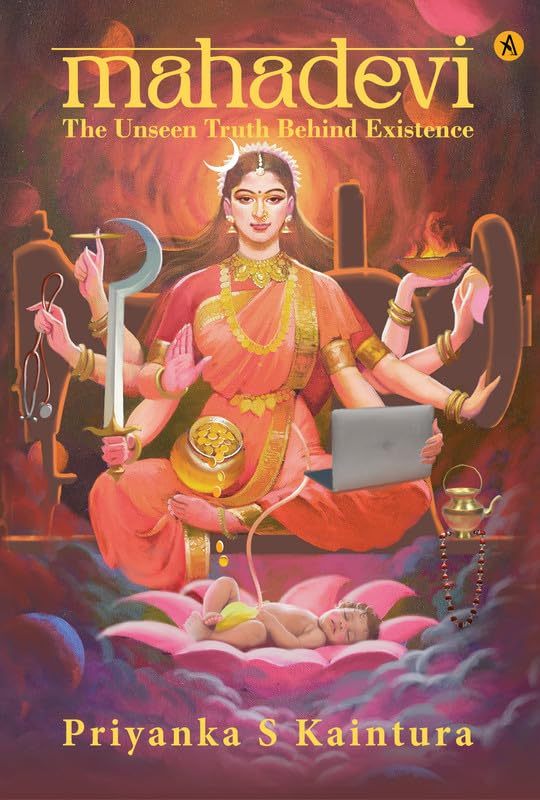
0 notes
Text
Chaitra Navratri 2025: A Sacred Celebration of Goddess Durga
Chaitra Navratri marks the nine-day festival of devotion, purity, and divine blessings, dedicated to Goddess Durga in her nine forms. This auspicious period, which falls in the Hindu month of Chaitra (March-April), is not only a time for spiritual rejuvenation but also symbolizes the victory of good over evil.
Let’s dive into the significance, importance, rituals, and spiritual benefits of Chaitra Navratri and how you can celebrate it to invite divine grace into your life
Significance of Chaitra Navratri
Chaitra Navratri is also known as Vasant Navratri, as it welcomes the spring season. It is believed that during these nine days, Goddess Durga descends to bless her devotees, helping them overcome obstacles, cleanse past karmas, and attain inner peace.
This festival is also significant because Lord Rama’s birthday (Ram Navami) falls on the ninth day of Navratri, making it even more sacred. Devotees worship Lord Rama along with Goddess Durga, seeking his divine blessings for strength and righteousness.
Importance of Chaitra Navratri in Hinduism
1. Spiritual Cleansing – Navratri is a time to purify the mind, body, and soul through fasting, meditation, and devotion.
2. Victory of Good Over Evil – The festival celebrates Goddess Durga’s triumph over Mahishasura, inspiring people to conquer their inner demons.
3. Beginning of the Hindu New Year – In many regions, Chaitra Navratri marks the start of the Hindu lunar calendar, making it a spiritually powerful time to set positive intentions.
4. Astrological Significance – This period aligns with planetary transitions, making it ideal for prayers and manifestations.
5. Boosts Positive Energy – The vibrations created through mantras, havans, and bhajans cleanse negative energies from the surroundings.
Navratri Rituals: How to Observe It
1. Ghatasthapana (Kalash Sthapana) – The Beginning of Navratri
The first day starts with Ghatasthapana, where a kalash (sacred pot) is placed and worshipped, symbolizing the presence of Goddess Durga. This marks the beginning of the nine-day spiritual journey.
2. Fasting and Food Practices
Many devotees observe a Navratri fast, consuming only fruits, milk, and satvik food.
Some follow nirjala vrat (without water) or phalahar vrat (only fruits and nuts).
Kuttu (buckwheat), singhara (water chestnut), and samak rice are commonly eaten.
Onion, garlic, and non-vegetarian food are avoided.
3. Daily Worship and Goddess Durga’s Nine Forms
Each day is dedicated to a different form of Maa Durga:
1. Day 1 – Shailputri Mata (Goddess of Stability)
2. Day 2 – Brahmacharini Mata (Goddess of Devotion)
3. Day 3 – Chandraghanta Mata (Goddess of Courage)
4. Day 4 – Kushmanda Mata (Goddess of Creativity)
5. Day 5 – Skandamata Mata (Goddess of Motherhood)
6. Day 6 – Katyayani Mata (Goddess of Power)
7. Day 7 – Kalaratri Mata (Goddess of Destruction of Evil)
8. Day 8 – Mahagauri Mata (Goddess of Wisdom)
9. Day 9 – Siddhidatri Mata (Goddess of Miracles & Blessings)
4. Havan, Bhajans, and Meditation
Havan (sacred fire ritual) is performed on Ashtami or Navami to invoke divine blessings.
Devotees chant Durga Saptashati or Devi Mahatmya to seek Maa Durga’s protection.
Meditation and yoga during Navratri enhance spiritual energy and mental clarity.
5. Kanya Pujan (Worship of Little Girls)
On the eighth (Ashtami) or ninth (Navami) day, young girls (Kumaris) are worshipped as incarnations of the goddess. They are offered prasad, such as puri, chana, and halwa, and are given gifts and blessings.
Spiritual and Personal Benefits of Observing Chaitra Navratri
Brings Prosperity & Wealth – Praying to Goddess Lakshmi attracts financial abundance.
Removes Negative Energies – Fasting and chanting increase positive vibrations.
Increases Willpower & Self-Discipline – The practice of fasting improves focus and control over desires.
Helps Manifest Goals – Setting intentions during Navratri can bring success and spiritual growth.
Celebrate Chaitra Navratri 2025 with Live Bhagwan
This Chaitra Navratri 2025, immerse yourself in devotion, purify your soul, and welcome divine blessings into your life. Stay connected with Live Bhagwan for daily Navratri rituals, fasting tips, and spiritual guidance.
For more insights on Hindu festivals, Ekadashi fasts, and divine teachings, visit www.livebhagwan.com. Let’s embrace this divine period with devotion and faith!
0 notes
Text
Shakti Peethas and Their Importance
What are Shakti Peethas? Shakti Peethas are sacred Hindu temples dedicated to Goddess Shakti (Devi Durga or Parvati). These holy sites are believed to have formed where parts of Goddess Sati’s body or her ornaments fell when Lord Shiva carried her after her self-immolation. According to Hindu mythology, Sati, the first wife of Lord Shiva, sacrificed herself in the Daksha Yagna. Enraged, Lord…

View On WordPress
0 notes